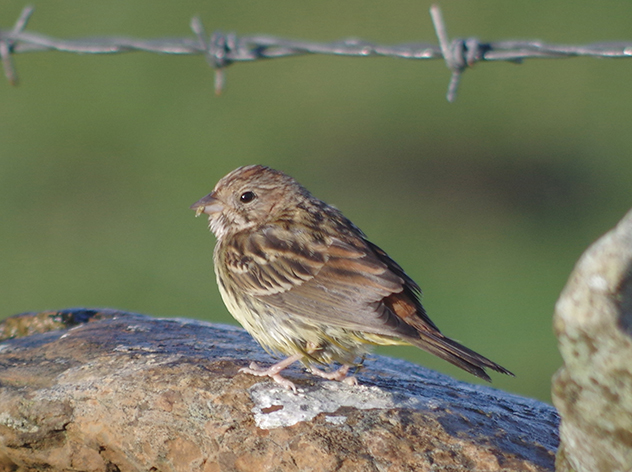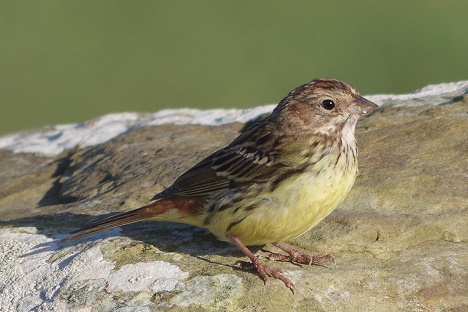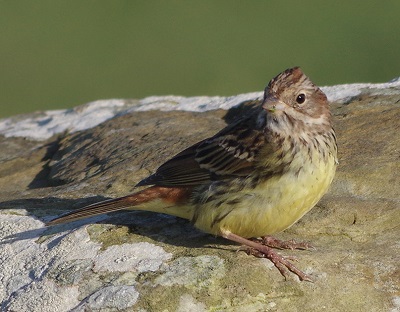Birds on Papa Westray

Chestnut Bunting - photo by Jonathan Ford (Papay Ranger)
Papa Westray has well and truly been placed on the birding map, thanks to the discovery of what looks set to be recognised as Britain's first ever Chestnut Bunting, a vagrant from the furthest corner of Asia. The bird was glimpsed first on 19th October 2015, but it was only on Saturday 24th October that its favoured spot was found, on the track to the Knap of Howar, and its identity could be confirmed.
The bird stayed until the evening of 29th October. The skies of Papay were alive with other surprise visitors during its stay as charter flights full of twitchers arrived to see this rarity. Around 140 people made the pilgrimage. Most went away delighted with their views of this tiny and confiding bird as it fed on Annual Meadow-grass seeds along the track, showing off its lemon-yellow belly, neat streaking, reddish-brown rump and subtly patterned head. Sadly for visitors on Friday 30th, a clear moonlit night had led to the bunting's departure, and the day saw some very disappointed faces - a very smart Black Redstart seemed to be very little compensation for them.

|

|
Chestnut Bunting - photos by Jonathan Ford (Papay Ranger)
Around 150 species of bird have been seen around the island in 2015, including White-rumped Sandpiper from America, Glossy Ibis from the Mediterranean, Icterine Warbler, Bluethroat and Barred Warbler from Scandinavia and a host of Yellow-browed Warblers from Russia. The species total for 2016 looks set to be higher still, with highlights so far including Pectoral Sandpiper, Red-necked Phalarope, Grey Phalarope and large numbers of Lapland Buntings. Whilst rare and scarce birds provide added excitement at times, it is the wealth of birds that can be found on the island every day of the year which makes Papay so special for birds and the birdwatcher.
Northern specialities like Twite, Hooded Crow and Black Guillemot (known here as Tysties) are found around the year. The beaches generally have a wealth of waders, with it being readily possible to see ten or more species here in a day.
Spring brings the return of the breeding Sandwich and Arctic Terns, Bonxies (Great Skuas) and Arctic Skuas. The RSPB North Hill reserve still has tens of pairs of skuas, which firmly defend their territories against people navigating the coastal path. Dozens of pairs of waders also breed on the hill, including Dunlin and Golden Plover, whilst the island's fields are home to nesting Lapwing, Curlew, Snipe, Redshank and Oystercatcher. Papa Westray has been a stronghold for Corncrakes in Orkney, but in the last couple of years it seems that they have spent their summers in Westray instead - we hope for their return to this island in the coming breeding season.
Four species of auk breed here, but 1812 and 1813 saw the tragic collection of Britain's last pair of breeding Great Auks from their nest site on Fowl Craig. The species become globally extinct soon afterwards, and a small monument to this terrible waste at the hands of humanity stands on the cliff top.
When the breeding season is over, birds flood through Papay as they move south from the Arctic and Scandinavia to warmer climes. This is the best season for seeing something out of the ordinary. The elegant Whooper Swans provide a spectacle on the Loch of St Tredwell during October. As winter comes in, many of these birds move further south, but mid-winter still provides a superb birdwatching experience, with Great Northern Divers, Eiders and Long-tailed Duck in the bays, Sanderling scurrying along the sandy beaches and the chance of Snow Bunting around the coast or on North Hill.